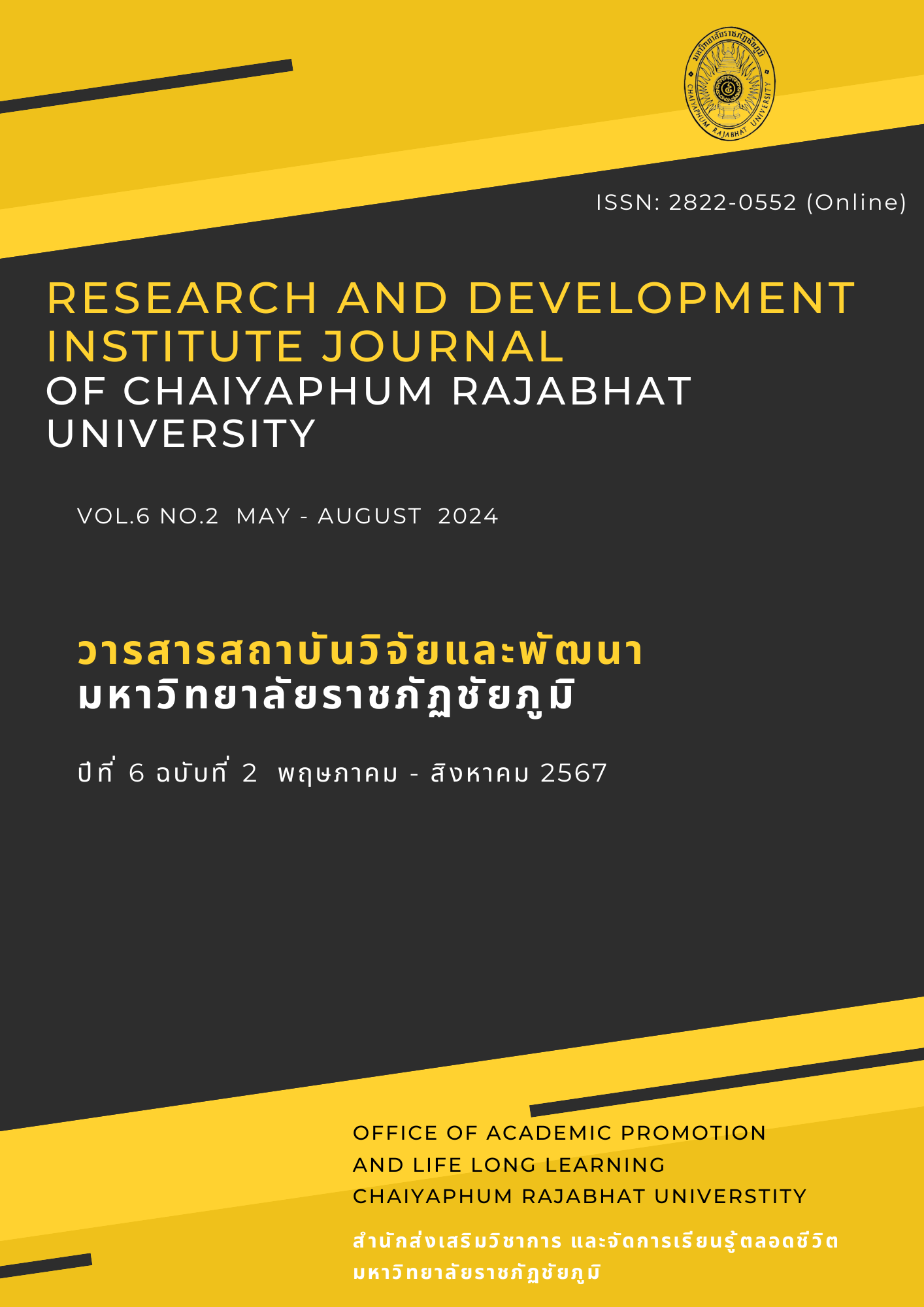DEVELOPMENT OF AN ITEM BANK SCIENCE AND TECHNOLOGY FOR MATHAYOMSUKSA 3 STUDENTS
Main Article Content
Abstract
This research aims to develop a science and technology item bank for Grade 9 students using the 2-parameter item response theory (IRT). The sample used in this study comprised 2,167 Grade 9 students in the Northeastern region during the second semester of the 2023 academic year, selected through multi-stage sampling. The research instrument was a multiple-choice test with four options. The parameters of the test items were analyzed using the item response theory model, which assesses individual item scores using the R programming language and the MIRT package. The research results revealed that a total of 543 science exam items were constructed for Grade 9 students. Content validity was assessed by experts, with 485 items meeting the criteria, showing a content validity index ranging from 0.80 to 1.00. The exam is divided into 10 editions, 50 questions each, with 10 shared questions in the set. These were tested with the sample group, and the test results were calibrated using the R programming language and the Equate package. Calibration was performed using the Haebera Method's item characteristic curve, resulting in 289 quality items. The item parameters included difficulty levels ranging from -0.84 to +2.50, with an average of 0.40 and a standard deviation of 0.21. The discrimination values ranged from 0.50 to 2.52, indicating that the items varied from moderate to high difficulty. The constructed item bank utilized PhpMyAdmin to create a database containing images, numbers, and text. This database will be used to develop a computer adaptive testing program in the future.
Article Details

This work is licensed under a Creative Commons Attribution-NonCommercial-NoDerivatives 4.0 International License.
Permission to use text, content, images, etc. of publication. Any user to read, download, copy, distribute, print, search, or link to the full texts of articles, crawl them for indexing, pass them as data to software, or use them for any other lawful purpose. But do not use it for commercial use or with the intent to benefit any business. Published under a Creative Commons Attribution-NonCommercial-NoDerivatives 4.0 International License.

This work is licensed under a Creative Commons Attribution-NonCommercial-NoDerivatives 4.0 International License
References
เบญจมาภรณ์ เสนารัตน์. (2558). การพัฒนาเครื่องมือประเมินความสามารถทางการวิจัยการศึกษาของนักศึกษาครู มหาวิทยาลัยราชภัฏในภาคตะวันออกเฉียงเหนือ. [วิทยานิพนธ์ปริญญาดุษฎีบัณฑิต]. มหาวิทยาลัยมหาสารคาม.
เบญจมาภรณ์ เสนารัตน์ และสมประสงค์ เสนารัตน์. (2560). หลักการวัดและประเมินผลทางการศึกษา (พิมพ์ครั้งที่ 3). มหาสารคาม: อภิชาตการพิมพ์.
เบญจมาภรณ์ เสนารัตน์ และสมประสงค์ เสนารัตน์. (2561). หลักการวัดและประเมินผลทางการศึกษา (พิมพ์ครั้งที่ 4). มหาสารคาม: อภิชาตการพิมพ์.
ศักดิ์ชัย จันทะแสง เสรี ชัดแช้ม และปิยะทิพย์ ประดุจพรม. (2562). การพัฒนาวิธีการจัดคลังข้อสอบตามค่าอำนาจจำแนกของข้อสอบแบบเป็นช่วงของแต่ละระดับชั้นร่วมกับการจัดสมดุลเนื้อหา. วารสารวิทยาการวิจัยและวิทยาการปัญญา, 16(2). 109-125.
ศิริชัย กาญจนวาสี. (2555). ทฤษฎีทดสอบแนวใหม่.(พิมพ์ครั้งที่ 4). กรุงเทพฯ: จุฬาลงกรณ์มหาวิทยาลัย.
ศิริชัย กาญจนวาสี. (2563). ทฤษฎีการทดสอบแนวใหม่ (MODERN TEST THEORY) (พิมพ์ครั้งที่ 5). กรุงเทพฯ: จุฬาลงกรณ์มหาวิทยาลัย.
สำนักงานคณะกรรมการการศึกษาขั้นพื้นฐาน กระทรวงศึกษาธิการ. (2560). ตัวชี้วัดและสาระการเรียนรู้แกนกลาง กลุ่มสาระการเรียนรู้วิทยาศาสตร์ (ฉบับปรับปรุง พ.ศ. 2560) ตามหลักสูตรแกนกลางการศึกษาขั้นพื้นฐาน พุทธศักราช 2551. กรุงเทพฯ : ชุมนุมสหกรณ์การเกษตรแห่งประเทศไทย จำกัด
สถาบันส่งเสริมการสอนวิทยาศาสตร์และเทคโนโลยี. (2561). ผลการประเมิน PISA 2015 วิทยาศาสตร์ การอ่าน และคณิตศาสตร์ (ฉบับสมบูรณ์). กรุงเทพฯ: สถาบันส่งเสริมการสอนวิทยาศาสตร์และเทคโนโลยี (สสวท.).
สถาบันส่งเสริมการสอนวิทยาศาสตร์และเทคโนโลยี. (2565, 30 พฤษภาคม). สสวท. เร่งยกระดับผลการเรียนรู้วิทย์-คณิต เผยเหตุปัจจัยพัฒนาคุณภาพผู้เรียน. https://www.ipst.ac.th/news/27587/20220530-news.html
สถาบันส่งเสริมการสอนวิทยาศาสตร์และเทคโนโลยี. (2567, 7 กุมภาพันธ์). ผลการประเมิน PISA 2022 : บทสรุปสำหรับผู้บริหาร. https://pisathailand.ipst.ac.th/pisa2022-summary-result/
สุวิมล กฤชคฤหาสน์ และสุวิมล ติรกานันท์. (2560). การพัฒนาคลังข้อสอบกลุ่มสาระการเรียนรู้คณิตศาสตร์ สำหรับระดับมัธยมศึกษาปีที่ 4. วารสารศรีนครินทรวิโรฒวิจัยและพัฒนา สาขามนุษยศาสตร์และสังคมศาสตร์ 9(17). 145-159.
อภิญญา พลยืน สมประสงค์ เสนารัตน์ และเบญจมาภรณ์ เสนารัตน์. (2566). การพัฒนาคลังข้อสอบวิชาคณิตศาสตร์ เรื่อง จำนวนเต็ม สำหรับนักเรียนชั้นมัธยมศึกษาปีที่ 1. วารสารสถาบันวิจัยและพัฒนา มหาวิทยาลัยราชภัฏชัยภูมิ, 5(2). 73-84.
Albano, A. D. (2016). equate: An R Package for Observed-Score Linking and Equating. Journal of Statistical Software, 74(8), 1–36. https://doi.org/10.18637/jss.v074.i08
Chalmers, R. P. (2012). mirt: A Multidimensional Item Response Theory Package for the R Environment. Journal of Statistical Software, 48(6), 1–29. https://doi.org/10.18637/jss.v048.i06
Millman, J., & Arter, J. A. (1984). Issues in Item Banking. Journal of Educational Measurement, 21(4), 315-330.
Weiss, D. J. (2011). Better data from better Measurements using computerized adaptive testing. Journal of Methods and Measurement in the Social Sciences, 2(1), p. 1-27.

